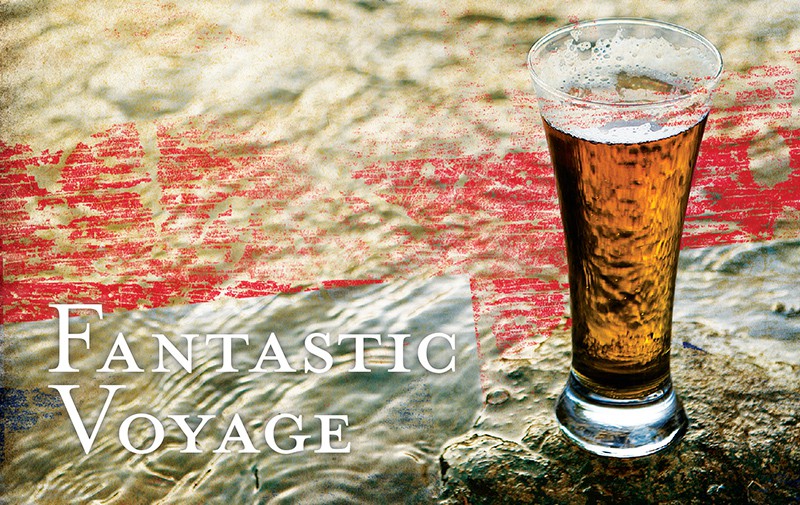
In the late 1700s, brewing was big business in England. As British colonists traveled throughout the world, breweries were charged with the task of providing the comforting flavors of hometown ales to countrymen thousands of miles away. The problem, of course, was that the road from brewery to consumer was a long and arduous one.
Certainly this was the case when supplying thirsty Englishmen in colonial India. With the hot climate and poor water supply, brewing in places like Calcutta was not an option. Instead the British relied on trade ships to transport large wooden casks of beer from country to country. But after weeks at sea, the dark, rich beers so commonplace in London would be received at Indian ports with a great deal of disappointment—the stuff was flat and downright funky. Beer is a living thing, after all, and prone to spoilage when stored in the hull of a warm ship.
A brewer named George Hodgson, however, solved this dilemma. He and other British brewers had been making pale ale, which showcased the refreshing bitterness and earthy aromatics of a staple beer ingredient: hops. Hops had always served as a flavoring and bittering agent in beer, but its preservative quality allowed Hodgson to create beer that would tolerate long voyages.
Hodgson’s India ale, as it was originally called, was brewed to a much higher level of alcohol—another preservative—and with a great deal more hops. By aging this ale prior to shipment, Hodgson also ensured that most living yeast in the beer died off, minimizing spoilage. The resulting beer showed quite well when it came off the ship in India—clear and boozy with an assertive floral aroma. As Hodgson’s brew gained fans in the British colonies, its fame also spread throughout England and Continental Europe. Soon, breweries around the world, including the Americas, were making India Pale Ale, or, simply, IPA.
Characteristically, modern-day American craft brewers have taken the original English IPA and made it their own, with an aggressive use of citrusy and piney West Coast–grown hops. But the true English IPA can be far more complex and exhibit a wonderful malt profile not commonly found in American counterparts. While American IPAs tend to exhibit a resinous hop bitterness that threatens to strip teeth of their enamel, English versions offer a more subtle bitterness, hoppy aroma, and often toasty, caramel-like sweetness. Not surprisingly, these old-world versions match well with British cheese.
Belhaven Twisted Thistle IPA and Coolea
Brewed in Scotland, Belhaven beer began to spread throughout Europe once commercial railways entered Dunbar in the early 1800s. Its IPA blends Scottish and British brewing traditions, boasting a superbly pronounced malt flavor. Of the three IPAs mentioned here, Belhaven’s has the most gentle hop profile, even though it blends some spicy and piney hop varietals. Another lower-alcohol (5.3%) IPA, the medium-bodied Twisted Thistle pours an orangey hue and has a pleasant medium body. When it’s matched with Irish Coolea from the Willems family, you’ll be glad that this IPA has an assertive caramel—bordering on buttery—backbone to match the cheese’s similar notes. Complementary flavors between this style of beer and cheese are unique. As is often the case with hoppy beers, the Belhaven’s bitter finish does well to cut through Coolea’s richness.
Fuller’s India Pale Ale and Keen’s Cheddar
Fuller’s has been crafting beer in Chiswick, England, for roughly 350 years, and India Pale Ale is just one of its classic, bitter brews. Fuller’s modern-day IPA glows pale amber and sits at a modest 5.3% alcohol level. Up front is bready sweetness; a fruity, floral hop bouquet on the nose results from an English hop variety called Golding, known for its gentle aroma; and a pleasant bitterness comes through at the end, leaving a bright finish. The balance between palate-cleansing hops and biscuity flavors pairs perfectly with the nutty taste of Keen’s Cheddar.
Meantime India Pale Ale and Stichelton
Since Meantime has only been brewing for roughly ten years, it is especially impressive that its IPA is widely regarded as one of the finest examples of the original style. At 7.5% alcohol, it is far boozier than the other two examples here, complete with a bold hop aroma and bitterness. More than two pounds of English hops (Golding and Fuggles) are added to each barrel of beer, resulting in wonderfully earthy and citrusy aromas and honey-malt sweetness. The higher alcohol levels deliver a noticeable warming sensation, and fruity esters border on orange marmalade. The complexity of Meantime’s IPA suits Joe Schneider’s raw-milk blue, Stichelton. Their common flavors—caramel, nuttiness—play well together, while the alcohol and citrusy hops notes balance the cheese’s spicy, buttery mouth-feel.







